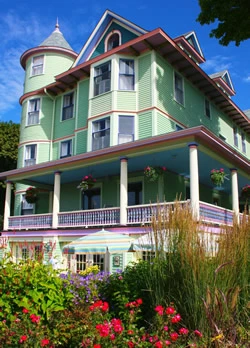Mackinac Island’s Changing Shores: A Climate Story for Visitors
Introduction
Mackinac Island is one of Michigan’s most loved vacation spots. It offers natural beauty, rich history, and a peaceful, car-free environment. Visitors enjoy biking, horse-drawn carriages, and walking along the shoreline. But lately, people have started noticing quiet changes around the island.
The shoreline, once steady and strong, is beginning to shift. Water levels rise and fall more than before. Some paths are washing out. Certain beaches look different each year. These changes aren’t just normal. They’re part of a bigger climate story.
This article explains how the island’s shores are changing. It’s written for people who want to visit and learn more. If you love nature and want to protect it, this story matters to you.
A Brief Overview of Mackinac Island’s Geography
Between the Upper and Lower Peninsulas of Michigan, in Lake Huron, is Mackinac Island. It’s about 3.8 square miles in size. Most of the island is a state park filled with forests, trails, and rock formations.
The shoreline has many natural features. Visitors can see:
- Limestone bluffs rising above the lake
- Sandy beaches near the downtown area
- Wetlands and marshes along quiet corners of the island
The island is special because of its location in the Great Lakes. For years, the climate here was stable. Winters brought snow and ice. Summers were cool and breezy. But now, things are shifting.
What’s Changing? The Visible Signs of Shoreline Impact
In recent years, shoreline changes have become easier to see. Walk along the coast, and you might notice something’s different. Trees near the waterline have toppled. Some trails are now blocked by erosion. Boardwalks need repairs more often.
Here are a few changes visitors have reported:
- Higher water levels in spring and early summer
- Beaches shrinking or vanishing after storms
- Paths once used for biking now cut off by water
- New sandbars forming in unexpected areas
These aren’t just one-time events. Many of these signs repeat each year. Even locals and park staff say the island doesn’t look the same anymore.
Waves now reach areas that stayed dry for decades. Rainfall comes harder and faster. And less winter ice means the water hits the shore harder. These changes are part of a larger trend seen across the Great Lakes.
Still, the island is beautiful. The changes don’t ruin it. But knowing what’s happening helps visitors enjoy the trip with fresh eyes. It also inspires us to find better ways to preserve it.
How Climate Change Is Affecting the Island
There is a reason why Mackinac Island’s shoreline varies. They contribute to a broader change in the climate. Weather patterns are becoming more intense across the Great Lakes region. These changes are affecting the land, water, and even wildlife.
One major factor is warmer air and water temperatures. Summers are hotter, and winters are shorter. Less ice forms on the lakes in winter. Ice once protected the island’s shore from strong waves. Without it, the shoreline takes more damage during storms.
Rainfall patterns have changed too. There are more heavy rain events in spring and fall. This leads to quick flooding and erosion in low areas. The soil washes away faster. Trails and shorelines can collapse or become unsafe.
Additionally, the Great Lakes’ water levels are fluctuating more frequently. Some years bring record highs, while others drop too low. These extreme shifts put stress on the shoreline. Trees and plants near the water suffer. This weakens the land and makes it easy to break apart.
Here are some of the climate effects seen on Mackinac Island:
- Less ice cover in winter, leading to more erosion
- Hotter summers drying out forest areas
- Stronger winds and waves hitting unprotected shores
- Sudden rainstorms damaging walking and biking paths
Human activity plays a small role too. While cars are not allowed on the island, boat traffic and shoreline development add stress. When visitors step off trails or onto fragile dunes, it adds pressure to already weak spots.
Why It Matters to Visitors
These changes are important for anyone planning to visit the island. While the island is still safe and beautiful, some areas look different each season. Trails may be closed or re-routed. Beach areas might shrink or be too wet to walk on.
Wildlife also feels the impact. Birds may nest in new spots. Plants that once grew in certain areas may move or disappear. This affects nature walks and viewing spots for visitors.
Here’s why visitors should care:
- Some scenic spots may look different than in guidebooks
- You might have to reconsider your biking or hiking plans.
- Knowing the changes helps you explore more safely and responsibly
Being aware helps you enjoy the island while respecting its fragile beauty.
How the Island Is Adapting
Mackinac Island is not ignoring the changes. Local groups and park officials are taking action. They want to protect the shoreline and keep it safe for visitors.
Erosion control is one major effort. Park crews build barriers near fragile areas. These stop waves from hitting the shore too hard. Trails close when they are unsafe, and signs warn visitors to keep off weak paths.
Conservation groups work with the island to protect plants and trees. To keep the soil in place, they grow native grasses. These grasses help stop sand and dirt from washing away.
Visitors will also notice new educational signs along trails. These signs explain what’s changing and why it matters. Some tours even talk about climate and how it affects the island.
Projects like these include:
- Placing stones to protect from wave damage
- Rebuilding paths that washed out during storms
- Teaching visitors about climate through signs and ranger talks
- Working with experts to monitor lake levels and erosion
These actions help keep Mackinac Island strong and beautiful.
What You Can Do as a Visitor
The island’s protection is greatly helped by visitors. Simple actions make a big difference. Follow signs and stay on marked trails. This helps prevent further erosion. Don’t step on sand dunes or wild plants.
Be kind to wildlife. Don’t feed animals or disturb their homes. Keep a safe distance when taking photos.
Here are a few helpful tips for eco-friendly travel:
- Stay on paths and avoid walking close to crumbling edges
- Carry out all trash, even small pieces like wrappers
- Instead of purchasing plastic water bottles, bring reusable ones.
- Encourage nearby businesses that use eco-friendly techniques.
- Ask park staff about how you can help during your visit
By acting responsibly and respectfully, you help protect Mackinac Island’s well-being.
Conclusion
Mackinac Island is changing, but it’s still a place of wonder. Its trails, forests, and shoreline continue to inspire visitors every season. Understanding what’s happening helps you see the island with fresh eyes. As a visitor, you can enjoy its beauty while helping protect it for years to come.
For a comfortable and thoughtful stay, consider booking a room at Inn on Mackinac. This delightful inn combines vintage elegance with modern comforts, offering the perfect retreat after a day of adventure. Additionally, it’s a fantastic method to help out local companies that are concerned about the future of the island.
Category: Mackinac Island


